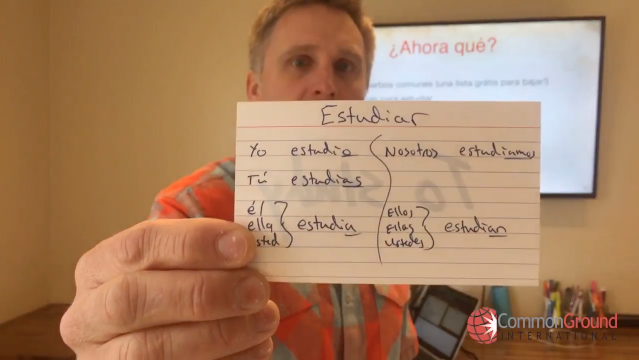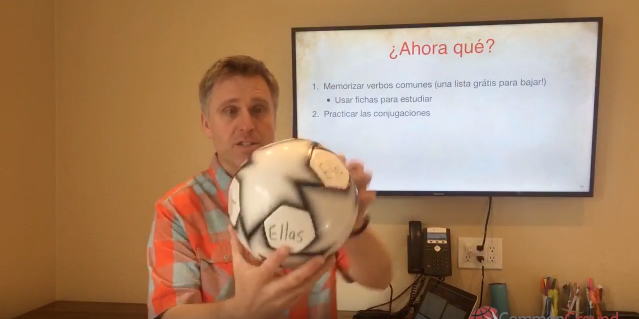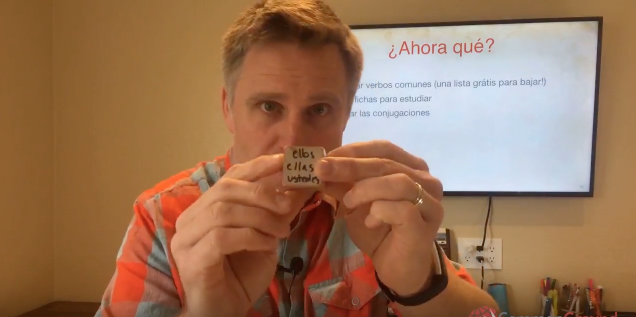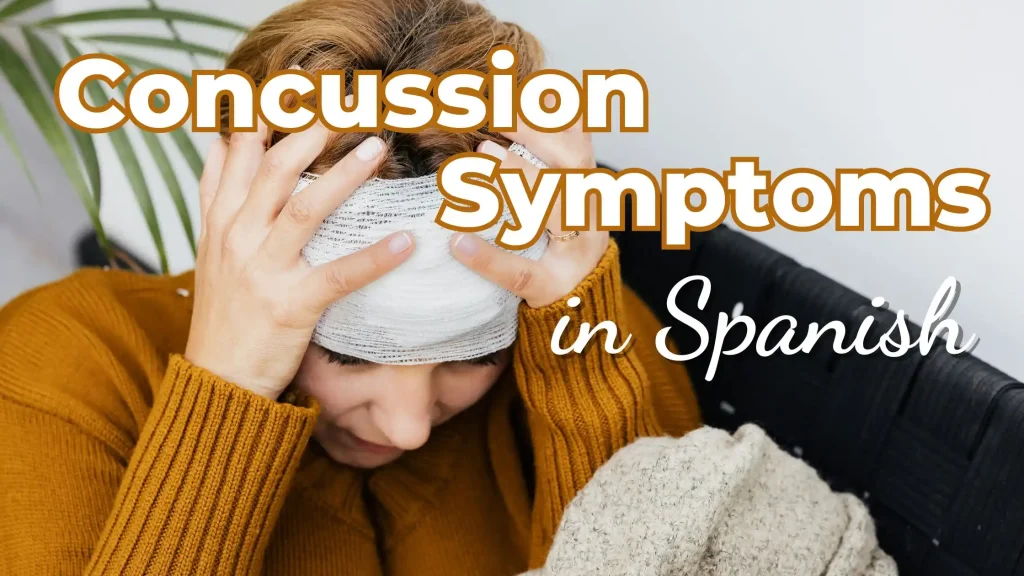This free Medical Spanish lesson focuses on learning and understanding the use of the Regular Present Tense Verbs in Spanish for healthcare context.
Here is the video lesson about the Regular Present Tense Verbs in Spanish that I taught to the Facebook group.
Empezamos con una lección sencilla pero fundamental: Los verbos regulares en tiempo presente en español relacionados con la salud.
Algunos ejemplos:
- La asociada médica examina al paciente
 : The female PA examines the pacient. (Examinar = To examine):
: The female PA examines the pacient. (Examinar = To examine): - El paciente respira profundo: The patient breathes deeply. (Respirar = To breathe)
- El paciente sufre de dolor de pecho: The patient suffers from chest pain. (Sufrir = To suffer)
- El paciente no come bien: The patient doesn’t eat well. (Comer = To eat)
- El paciente no controla su azúcar: The patient doesn’t control his/her blood sugar. (Controlar = To control)
- Él bebe demasiadas bebidas azucaradas
 : He drinks to many sugary drinks. (Beber = To drink)
: He drinks to many sugary drinks. (Beber = To drink)
Algunas preguntas:
- ¿Sufres tú de dolor de pecho?
 : Do you suffer from chest pain?
: Do you suffer from chest pain?
- No, gracias a Dios yo no sufro dolor de pecho: No, thank God I don’t suffer from chest pain.
- ¿Come usted bien?: Do you eat?
- A veces yo como bien, a veces no como bien: Sometimes I eat well, sometimes I don’t eat well.
Note: Both “Tú” and “Usted” mean “You”. You’ll learn how to use them properly later. Also, is good for you to know that in some regions in Latin America (mostly in Argentina, Uruguay and some cities in Colombia), people use “Vos” instead of Tú and Usted. The conjugation are quite similar and you don’t need to worry about learning this variant since they are going to understand what you are saying when using Tú or Usted 🙂
- ¿Bebe usted demasiadas bebidas azucaradas?: Do you drink to many sugary drinks?
Los sujetos en español / Subjects in Spanish
As we study the subjects, you’ll notice that they actually dictate the conjugations of the verbs in Spanish.
Singular |
Plural |
|---|---|
|
Yo = I |
Nosotros = We |
|
Tú = You (for kids) |
|
|
Él = He |
Ellos = They |
|
Ella = She |
Ellas = They (women) |
| Usted = You (for 13+) | Ustedes = You all |
* Note: Although it is good to know the meaning of the “vosotros” form, it is not mandatory to learn how to conjugate it since it is only used in Spain. People from Latin America prefer to use the “ustedes” form.
What About “Vos”?
In some Latin American countries, such as Argentina and Uruguay (and even some provinces in Venezuela and Colombia), people use the form “vos” instead of “tú” when speaking. You don’t need to learn it but it’s good for you to know if you hear your Latino patient using this particular form when talking to you. Here some examples:
- Vos sos / estás: You are (note some verbs conjugated using the “tú” form)
- ¿Dónde vivís?: Where do you live? (Verbs ending in -e change to -ís in the present tense)
- Respirá hondo: Breathe deeply (with some verbs, you only need to add an accent at the end)
Again, this is a particular form used in some countries and requires an advanced level of Spanish to use it, so if a patient uses the form “vos” when talking to you, you can reply using “tú” or “usted” forms depending on the context.
Tres tipos de verbos en español / 3 Types of Verbs in Spanish
Each type of verbs has their own conjugation pattern depending on the subject you are using
|
-AR Verbs |
-ER Verbs |
-IR Verbs |
|
Examinar |
Comer |
Sufrir |
| Respirar | Beber | Vivir (To live) |
Steps in Conjugating Verbs in Spanish
Step 1: Drop the ending
|
-AR Verbs |
-ER Verbs |
-IR Verbs |
|
Examin__ |
Com__ |
Sufr__ |
| Respir__ | Beb__ | Viv__ |
Step 2: Add The Present Tense Ending to The Verb
1. Verbos -AR
Singular |
Plural |
|---|---|
|
Yo… o |
Nosotros… amos |
|
Tú… as |
|
| Él, Ella, Usted… a | Ellos, Ellas, Ustedes… an |
Examples:
RESPIRAR
Singular |
Plural |
|---|---|
|
Yo…respiro |
Nosotros… respiramos |
|
Tú… respiras |
|
| Él, Ella, Usted… respira | Ellos, Ellas, Ustedes… respiran |
Remember: ANY -AR REGULAR VERB in Spanish is going to take this pattern
2. Verbos -ER
You only need to change the “a” to “e” when working with -ER endings:
Singular |
Plural |
|---|---|
|
Yo… o |
Nosotros… emos |
|
Tú… es |
|
| Él, Ella, Usted… e | Ellos, Ellas, Ustedes… en |
Examples:
COMER
Singular |
Plural |
|---|---|
|
Yo… como |
Nosotros… comemos |
|
Tú… comes |
|
|
Él, Ella, Usted… come | Ellos, Ellas, Ustedes… comen |
3. Verbos -IR
-ER and -IR verbs are similar in conjugation except for the “nosotros” and “vosotros” forms:
Singular |
Plural |
|---|---|
|
Yo… o |
Nosotros… imos |
|
Tú… es |
|
| Él, Ella, Usted… e | Ellos, Ellas, Ustedes… en |
Examples:
VIVIR
Singular |
Plural |
|---|---|
|
Yo… vivo |
Nosotros… vivimos |
|
Tú… vives |
|
| Él, Ella, Usted… vive | Ellos, Ellas, Ustedes… viven |
Práctica
Let’s try to solve these exercises on your own:
- La doctora ________ (trabajar) en la clínica (The doctor works in the clinic).
- Nosotros _________ (estudiar) español (We study Spanish).
- Tú ______ (comer) muchas frutas y verduras (You eat a lot fo fruits and vegetables).
- Ustedes no ______ (beber) bebidas alcohólicas (You don’t drink alcoholic beverages).
- Yo ______ (vivir) en Colorado (I live in Colorado).
- Él ______ (sufrir) de Diabetes tipo 2 (He suffers from type 2 Diabetes)
Finally…
This is the most basic level of conjugating the regular present tense verbs in Spanish and, in order to master this lesson, here are some ideas and suggestions to get more practice:
1. Memorizar verbos comunes (A full list of 200 verbs in Spanish are available in the lesson download)
- Usar fichas para estudiar (Download them from Quizlet or create them by yourself)

2. Practicar las conjugaciones
- Dos ideas para practicar las conjugaciones


I packaged all of this into easily downloadable .pdf notes– Get your copy for free today!
Other Posts in this Medical Spanish Verb Tenses Series
Usted and Medical Spanish Formal Commands
Healthcare workers learning Spanish need to get comfortable with Spanish formal commands. Whether you’re giving…
How to use Conditional Tense in Medical Spanish Situations
The conditional tense verb conjugation in Spanish gives you the ability to add the subtle…
How to use Present Perfect verbs in medical Spanish contexts
The present perfect verb tense is quite possibly one of the most helpful tenses when…
Imperfect Past Tense Medical Spanish Verbs
The Imperfect past tense in Spanish is one of the easiest tenses to conjugate; there…
Irregular Preterite Tense Medical Spanish Verbs
One of the hardest aspects of the Preterite past tense in Spanish is conjugating the…
Preterite Past Tense Medical Spanish Verbs
You don’t get too far in a conversation before you start using the past tense…
Keep up the good work speaking responsible Spanish to your patients! Check out our other books, classes & products to help you !
*If the link isn’t working for you, you may need to unblock pop-ups in your browser settings












Pingback: Medical Spanish: Irregular Present Tense Verbs in Spanish